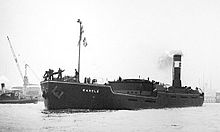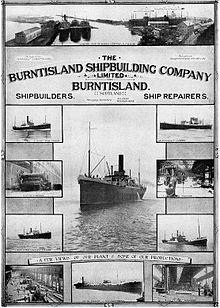Burntisland Shipbuilding Company

The shipbuilding company Burntisland Shipbuilding Company was founded as a makeshift shipyard in Burntisland , Fife , Scotland towards the end of the First World War .
history
Early years
The shipyard was built in 1918 by the two managing directors, the brothers Amos and Wilfrid Ayre, with four slipways for the construction of ships up to 140 meters long in the west dock of the port of Burntisland. It was set up as a kind of shipbuilding factory with a rail connection and an extensive rail system for the delivery and distribution of the required shipbuilding steel and the other components. Three standard type "C" freighters were built in the first year of operation . The shipyard then went on to build three-island tramp ships with five holds and continued with the construction of 20 colliers with four holds and engine rooms arranged in the middle. The shipyard also built some Archdeck necklaces during these years .
Interwar years
The orders for the construction of colliers and coastal freighters were evenly distributed over the years between the two world wars. In the years from 1921 to 1929, the Burntisland Shipbuilding Company built, among other things, twelve large tramp ships. In 1929 the shipyard presented its "Burntisland Economy" ship design, the low bunker consumption of which gave it a good reputation. The "Burntisland Economy" basic design was continuously developed by the shipyard, which meant that between 1935 and 1939 more than a dozen of them could still be sold. In addition, some necklaces and coastal ships were built in the "flat-iron" design in the 1930s . These had particularly flat structures and foldable masts and chimneys, which allowed them to pass even lower bridges.
Second World War
In the course of the Second World War, in addition to some military ships, merchant ships were built, which were delivered both to government agencies and to civilian clients. Primarily, the shipyard presented three frigates of the Royal Navy "hole" class, HMS Loch Killin , HMS Loch Fyne and HMS Loch Glendhu , done. The shipyard in Burntisland built sixty tramp ships, colliers, as freighters. In addition, the company received government contracts to build tramp ships, coastal freighters and aircraft transport ships.
post war period
After the war ended, the management remained in the hands of the Ayre brothers, under whose aegis the construction of high-quality tramp ships and liner freighters continued. Between 1945 and 1965, over 50 such ships were launched in Burntisland. In the 1950s, the Scottish and Mercantile Investment Company became the shipyard's majority shareholder.
In the 1960s, the shipyard with around 1000 workers built a series of coasters for the shipping company Metcalf Motor Coasters, as well as gas tankers and conventional tankers. In 1963 Sir Wilfrid retired after 45 years with the shipyard.
insolvency
In April 1967, a fast liner cargo ship for Pakistan, the Ohrmazd , was launched. During the construction of the ship, there were problems between the shipyard and the Pakistani owners of the Ohrmazd . In 1968 the Burntisland Shipbuilding Company went bankrupt after a financial crisis and in November 1968 the shipyard is in bankruptcy administration.
After the Ohrmazd , four last ships are launched from the Burntisland shipyard. Three of the 121.6 meter long cargo ships are for Hamburg customers. The motor ships Peter Schröder (September 1967) and Paul Schröder (February 1968) were for the Richard Schröder shipping company, and the Christiane Bolten (September 1968) was Wm. Miller's successor for Aug. Bolten . The last ship was the Helen Miller for the Liverpool St. Vincent Shipping Company. The launch of the Helen Miller took place in April 1969, the ship was completed in July 1969. A total of 422 ships were built by the shipyard. The shipyard equipment was then sold to the Robb Caledon Shipbuilders shipyard in Leith and Dundee.
Web links
- Burntisland Shipbuilding Co - Brief description of the shipyard at Grace's Guide
- Burntisland Shipyard - Detailed description of the shipyard at Burntisland.net (English)
- Ships built by the Burntisland Shipbuilding Company Ltd: arranged by date of launch - Complete list of ships at Burntisland.net (English)


